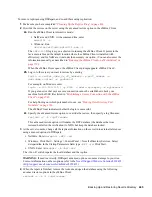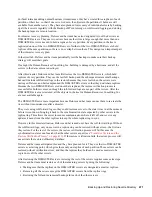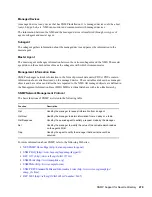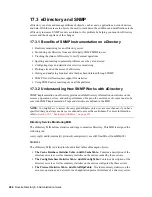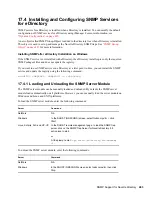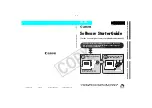
468
Novell eDirectory 8.8 Administration Guide
no
vd
ocx
(e
n)
6 Ap
ril 20
07
forward logs don't fill up the storage device. Occasionally he backs up the roll-forward logs to tape
and removes all except the one in use by eDirectory, to free up space.
The administrative overhead of turning on continuous roll-forward logging is worth it to Jorge,
because it gives him the up-to-the moment backup required for servers that participate in replica
rings. This way, if he needs to restore a server, the restored server will match the synchronization
state that other servers in the replica ring expect.
In his test lab, Jorge periodically tests his backup files to make sure his backup strategy will meet his
goals.
One Thursday at 2:00 p.m., the Linux server named Inventory_DB1 has a hard drive failure on the
drive containing eDirectory.
Jorge needs to gather the last full backup and the incremental backups since then, which will restore
the database up to the point of last night's incremental backup at 1:00 a.m. The roll-forward logs
have been recording the changes to the database since last night's backup, so Jorge will include them
in the restore to bring the database back to the state it was in just before the hard drive failure.
Jorge takes the following steps:
1. He gets a replacement hard drive for the server.
2. He gets the tape of the full backup for the server from the previous Sunday night.
The batch file he uses to run full backups every Sunday night places the backup file in
/
adminfiles/backup/backupfull.bk
.
He had specified a file size limit of 200 MB in the backup configuration settings, so there are
two backup files:
backupfull.bk.00001 (250 MB)
backupfull.bk.00002 (32 MB)
3. He also gets the tapes containing the incremental backups for Monday, Tuesday, and
Wednesday nights.
The batch file he uses to run incremental backups every weeknight places the backup file in
/
adminfiles/backup/backupincr.bk
.
Because he runs the same batch file every weeknight for the incremental backups of eDirectory,
they all have the same filename. He needs to give them new names when he copies them back
onto the server, because they all must be placed in the same directory during the restore.
4. Jorge installs the replacement hard drive.
In this case, the Linux operating system for the server was not on the hard drive that failed, so
he does not need to install Linux.
5. Jorge restores the file system from tape backup for the disk partitions that were affected.
6. Jorge reinstalls eDirectory, putting the server into a new temporary tree (the restore puts it back
into the original tree again later).
7. Jorge creates an
/adminfiles/restore
directory on the server, to hold the files to be
restored.
8. He copies the full backup (the set of two files) into that directory.
9. He copies the incremental backups for Monday, Tuesday, and Wednesday nights into the
directory.
Summary of Contents for EDIRECTORY 8.8 SP2
Page 4: ...novdocx en 6 April 2007...
Page 116: ...116 Novell eDirectory 8 8 Administration Guide novdocx en 6 April 2007...
Page 128: ...128 Novell eDirectory 8 8 Administration Guide novdocx en 6 April 2007...
Page 255: ...256 Novell eDirectory 8 8 Administration Guide novdocx en 6 April 2007...
Page 406: ...408 Novell eDirectory 8 8 Administration Guide novdocx en 6 April 2007...
Page 563: ...566 Novell eDirectory 8 8 Administration Guide novdocx en 6 April 2007...
Page 573: ...576 Novell eDirectory 8 8 Administration Guide novdocx en 6 April 2007...
Page 601: ...604 Novell eDirectory 8 8 Administration Guide novdocx en 6 April 2007...












